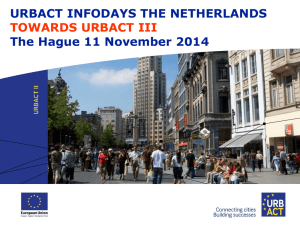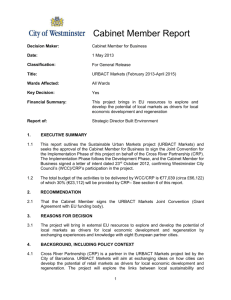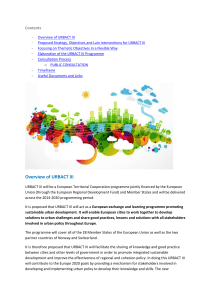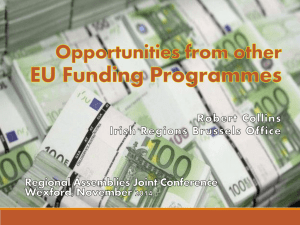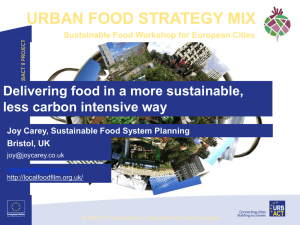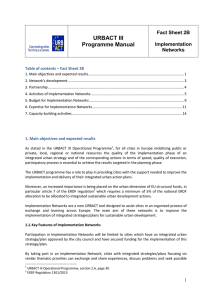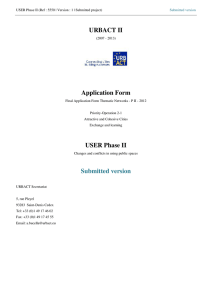URBACT - Sustainable Everyday Project
advertisement
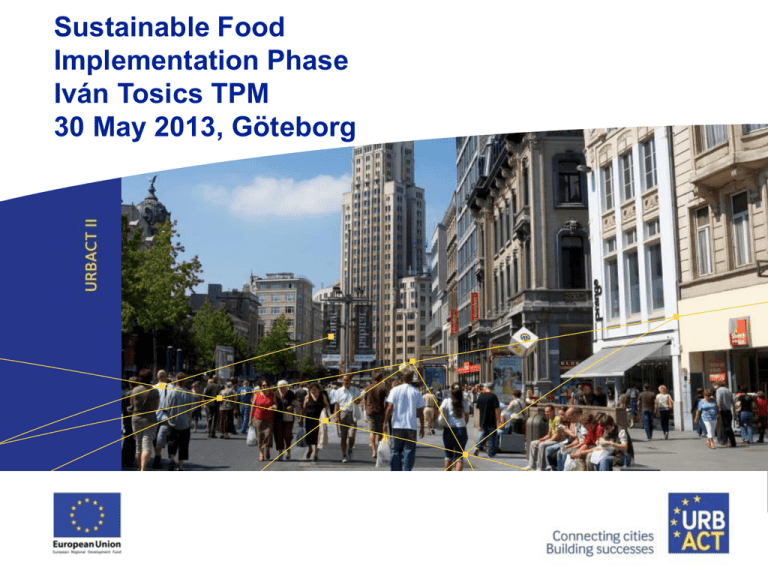
Sustainable Food Implementation Phase Iván Tosics TPM 30 May 2013, Göteborg Congratulations and welcome in the URBACT Community of Practice! 15 Thematic Networks approved for Implementation Phase More than 150 European cities currently involved Implementation to date 3 calls for proposals 2008: 19 thematic networks & 7 working groups (completed) 2010: 9 thematic networks (completed) 2012: 19 thematic networks (dvpt phase), 15 (impl phase) 540 partners involved in approved projects 90% cities Predominance of small & medium size cities 28 Member/ Partner states covered URBACT programme Monday, 13 April 2015 I Page 3 st ria Be lg iu Bu m lg ar i Cy a p ru Cz s ec h Re p. De nm ar k Es to ni a Fi nl an d Fr an ce Ge rm an y Gr ee ce Hu ng ar y Ire la nd Ita ly La tv ia Li th ua Lu ni xe a m bo ur g Ma Ne lta th er lan ds No rw ay Po lan d Po rtu ga Ro l ma nia Sl ov ak ia Sl ov en ia S p Sw ain itz er lan Tr an Sw d sn ed at en ion al As UK so ci ati on Au Geographical coverage 60 50 40 3rd call 30 2nd call 1rst call 20 10 0 URBACT programme Monday, 13 April 2015 I Page 4 Achievements to date 1. Project level Thematic outputs delivered by 26 completed projects 3800 persons involved in Local support groups (call 1 and Call 2 only) 250 Local Action Plans delivered (call 1 only) Intangible: new partnerships/ ways of working (ULSG survey 2011) « 90% declare ULSG has fostered the integrated approach » « 86% declare ULSG played a useful role in developing LAP » « 85% foresee ULSG will continue to operate after end of network » LAP implementation is a major issue (Mid Term Evaluation 2010) « 20% declare having received funds from OP for LAP implement° » « 60% declare having no secure funding for LAP implementation » 2. Programme level Thematic outputs (Cities responses to the crisis 2010, URBACT results 2011) 4 Annual conferences First Summer University for URBACT Local Support Groups (2011) URBACT programme Monday, 13 April 2015 I Page 5 Capitalisation on urban experience and knowledge URBACT Project Results published 2011 (Projects call 1) URBACT final conferences and events (Projects call 2) URBACT Workstreams launched 2012 • To bring forward URBACT’s answers for integrated & sustainable urban development to urban threats (report “Cities of Tomorrow”) • To identify, harness and transfer good practices from other ETC programmes (INTERREG IVC, ESPON, INTERACT) and relevant organisations • To issue practical recommendations to support European cities A wake-up call for cities The Cities of Tomorrow report is a wake-up call. European cities are ripe with marvellous opportunities but these are also under threat. The crisis has considerably worsened the situation and dramatically reduced the resources available to cities. However, most of the threats are due to long term underlying trends that started much earlier. Significant proportions of Europe’s youth were ‘NEET’ – not in education, employment or training – even before the current financial and economic crisis. In this context, business as usual is simply burying one’s head in the sand. Title of presentation I Monday, 13 April 2015 I Page 7 Threats (Cities of Tomorrow) Demographic decline Economic dvpt & competitiveness under pressure Growing social polarisation Depletion of natural ressources Responses 6 URBACT Workstreams Workstream 1 Demographic challenge in urban dvpt Workstream 2 Cities for more & better jobs Workstream 3 Inclusion through social innovation Workstream 4 Workstream 5 Workstream 6 Addressing sociospacial polarisation Sustainable mobility & accessibility Energy efficiency in housing URBACT workstreams outputs • URBACT Tribune 2012 • Workshops in the URBACT Annual Conference • Thematic papers and summary, May 2013 http://urbact.eu/en/urbact-capitalisation/outputs/reportscities-of-tomorrow-action-today/ Radical change in framework conditions of development Novelties of the present situation: • for a number of years there will be no economic growth • the capacities of the public sector will be much more limited than so far • the tolerance level of the people (regarding inequalities) is sharply decreasing Monday, 13 April 2015 I Page 10 Contradicting assumptions between goals Even strategies designed within an integrated framework lead to conflicting views Economic growth is considered as pre-assumption for creating more jobs while the growth paradigm is heavily criticized from the perspective of shrinking cities. Existing technical solutions are emphasized in handling energy and transport problems while new service delivery models, the inclusion of unusual suspects and smart financing are requested against marginalization of the youth. Clear energy saving and emission reduction targets are required for stimulating the demand for retrofit while the dominance of energy considerations is heavily criticized from the perspective of deprived areas and the fight against socio-spatial segregation. Title of presentation I Monday, 13 April 2015 I Page 13 New ideas are needed in planning and governance Urban planning and governance are key issues which have to address the demographic, rural (sustainability, food), energy, transport, climate, security topics at once. New ways of societal development have to be found. Besides the idea of green economy there is need for a further innovation: GREEN SOCIAL ECONOMY. Monday, 13 April 2015 I Page 14 REGIONAL DIMENSION FOOD CHAIN Governance related: City of Land Use Plan Amsterdam Governance related: City of Land Use Plan Amsterdam Public Discussion of Urban Food / Social Food topics Governance related: City of Public Discussion of Urban Food / Social Food topics Amsterdam •13-4-2015 •17 Governance related: City of Public Discussion of Urban Food / Social Food topics Amsterdam •13-4-2015 •18 Capacity Building Pilot Training Scheme for Elected Representatives 70 eligible applications were received from which 30 were selected. Venue: Brussels 6 from Italy, 4 from Spain, UK, 3 from Romania, 2 from France, Germany, Hungary, Portugal, 1 from Denmark, Greece, Latvia, Norway, Poland • Seminar 1: 8-10 April Integrated approach (horizontal between departments, vertical between layers of gov, geographical between neighbourhood, city, region) • Seminar 2: 16-18 September on participative approach, involving stakeholders • Seminar 3: 2-4 December on sustainability and change Title of presentation I Wednesday 27 March 2013 I Page 20 Title of presentation I Wednesday 27 March 2013 I Page 21 Capacity Building National Training Schemes for Local Stakeholders 1-2 seminars/country, national language, for ULSG members. Czech Rep – Slovakia: Brno, 20/21 May 2013 Denmark-Finland-Norway-Sweden: Malmö, 29/30 May France-Belgium: Paris, 11/12 June Germany: Berlin, 27/28 June Greece-Cyprus: Athens, 6/7 June Hungary: Budapest, 9/10 May Italy-Switzerland: Rome, 23/24 May Poland: Warsaw, 16/17 May Portugal: Lisbon, 6/7 June Romania: Bucharest, 21/22 May UK-Ireland: London, 6/7 June No date yet: Est-Lat-Lit, Neth-Belg, Spain DAY 1 Estimated time Topic 09.00 – 09.30 30 min 09.30 – 10.00 REGISTRATION Opening Welcome by the Host Institution, Trainer and Facilitator Get to know each other + give&take setting Objectives and programme for the seminar 60 min 10.00 – 11.00 URBACT method Urbact Video, Lecture on the Urbact Method, Group discussion, feedback 11.00 – 11.20 100 min 11.20 – 13.00 COFFEE BREAK ULSG Road Map Group exercise: Road Map puzzle. Debriefing. Lecture on ULSG Road Map 13.00 – 14.00 60 min 14.00 – 15.00 LUNCH BREAK Mutual learning/Networking Projects marketplace 20 min 15.00 – 15.20 130 min 15.20 – 17.30 COFFEE BREAK Stakeholder analysis Group discussion: Why do we need stakeholders? Introduction on stakeholders analysis & engagement. Group exercise: analysis grid on real projects. Peer review (2 projects) with guided Qs on stakeholder analysis and engagements. Debriefing 30 min 17.30 – 18.00 Reflection time Reflection on the day guided by LSG coordinators. Sharing key learning points 18.00 – 18.30 20.00 – 22.00 Session for LSG coordinators NETWORKING DINNER Title of presentation I Thursday 7 DAY 2 Estimated time Topic 09.00 – 10.30 External input Roundtable? Conference style? Q&A? 20 min 10.30 – 10.50 130 min 10.50 – 13.00 COFFEE BREAK Defining problems Introduction on defining problems Group exercise: case study + problems table Group presentations Debriefing 60 min 13.00 – 14.00 60 min 14.00 – 15.00 LUNCH BREAK Surgery Give and take, TBD 30 min 15.00 – 15.30 Reflection time Reflection on the day guided by LSG coordinators Sharing of key learning points LSG plan and take aways 30min 15.30 – 16.00 Closing Evals Salutation by Trainer and Facilitator. Salutation by the Host Institution DEPARTURES Title of presentation I Thursday 7 16.00 Capacity Building Summer University for Local Stakeholders Dublin, 28-30 August, 3 days, appr 400 participants 8 topics, LAB & ULSG work structure: action planning TED talks Master Classes Field visits Eligibility and cost covering • Programme level covers: LP+LE travel and accomodation • Project level covers: in average 2 persons/ULSG Title of presentation I Wednesday 27 March 2013 I Page 26 Title of presentation I Wednesday 27 March 2013 I Page 27 Title of presentation I Wednesday 27 March 2013 I Page 28 Title of presentation I Wednesday 27 March 2013 I Page 29 Title of presentation I Wednesday 27 March 2013 I Page 30 Title of presentation I Wednesday 27 March 2013 I Page 31 Title of presentation I Wednesday 27 March 2013 I Page 32 OECD delimitation of functional urban areas • OECD identification of FUAs – population grid from the global dataset Landscan (2000). Polycentric cores and the hinterlands of FUAs identified on the basis of commuting data, including all settlements from where at least 15% of the workers commute to any of the core settlement(s). • OECD defined four categories (total functional urban area): – – – – small urban areas with a population of 50 – 200 thousand; medium-sized urban areas (200 – 500 thousand), metropolitan areas (500 thousand – 1,5 million); large metropolitan areas (above 1,5 million population). • 29 OECD countries: 1175 functional urban areas. Public database: www.oecd.org/gov/regional/measuringurban • European OECD countries: 659 functional urban areas (29 large metropolitan areas and 88 metropolitan areas). European OECD Countries Austria Belgium Czech Rep Denmark Estonia Finland France Germany Greece Hungary Ireland Italy Luxembourg Netherlands Norway Poland Portugal Slovak Rep Slovenia Spain Sweden Switzerland UK Large Metropolitan Medium metroarea sized urban politan area (0,5 mill-1,5 area (1,5 mill - ) m) (200 th–500) 1 2 3 1 3 4 1 2 2 1 3 1 1 2 3 12 29 6 18 49 1 1 1 1 7 1 1 4 7 21 1 1 4 11 1 3 2 6 16 1 1 3 1 1 1 1 2 6 22 1 2 1 3 3 3 12 44 Small urban area (50 th– 200 th) 3 11 2 4 39 36 6 2 3 42 19 2 34 8 6 46 8 4 42 SUMM Share of pop in FUAs (%) 6 11 16 4 3 7 83 109 9 10 5 74 1 35 6 58 13 8 2 76 12 10 101 56,5 58,9 45,6 53,8 55,3 49,7 62,8 64,3 49,8 49,7 50,3 50,8 80,2 72,1 44,5 55,2 53,9 36,9 39,1 62,7 52,7 55,6 73,0 Madrid Barcelona 6,400,189 3,446,701 Valencia Sevilla Bilbao Málaga Zaragoza Las Palmas 1,482,901 1,347,611 1,007,708 859,889 766,042 581,146 Granada Palma de Mallorca Murcia Santa Cruz de Tenerife Valladolid Vigo Alicante/Alacant A Coruña Córdoba Pamplona/Iruña Cádiz San Sebastián/Donostia Oviedo Santander Gijón Vitoria/Gasteiz Salamanca León Elche/Elx Burgos Almería Sabadell 489,098 484,021 472,148 430,858 423,909 423,653 377,850 367,795 340,601 333,732 318,247 311,865 293,546 283,074 276,983 245,068 237,074 234,818 214,549 211,622 202,857 202,043 What is RURBAN…? Rural-urban links can take different forms Conventional contiguous city-hinterland forms: • morphological, • functional area, • broader economic area, • urban-rural region including also the rural hinterland A-spatial forms (Andrew Copus): • generic areas: not requiring contiguity in urban-rural links • organized proximity: translocal globalization of rural business for which proximity is irrelevant The OECD study on RURBAN discusses 11 case studies which all belong to the first forms. EU level interventions required for integrated urban development • For the success of EU2020 integrated planning (green and social economy strategies) is needed on the level of functional regions. • This new approach needs policy guidance and financial support from the EU, initiating crosssectoral and cross-territorial planning on the functional region level. Integrated solutions are needed: green economy (retrofitting), social economy (including the low skilled) New elemenst in European policy making for the 2014-2020 period • ITI: place-based integrated approach, potentially on metropolitan level (larger cities) • CLLD: people-based integrated interventions on local (smaller municipalities) and neighbourhood level • Horizon2020: spatially blind innovative economic actions Integrated sustainable urban development Example: Member State A Regional ERDF OP I T I Total allocation for ITI at least 5% of Member State’s ERDF, delegated to cities National/sectoral ERDF OP ESF OP City 3 City 1 City 2 City 3 City 25 City … CF OP + additional ESF and CF, if appropriate The metropolitan agenda and the new EU planning period (2014-2020) The development of tools of different policies is speeding up • Cohesion Policy 320-350 bn eur (?) – within ERDF the ITIs – within EAFRD the CLLDs – innovative urban actions around 0,3 bn (?) • Innovation Policy: Horizon 2020 appr. 80 bn eur Potential links between metropolitan ideas and European policies • narrow metropolitan areas (zero-sum game): ITIs, led by cities, in conjunction to CLLDs, led by public-private-thirdsector partnerships in smaller areas – the need for defined boundaries and (at least delegated) fixed institutional structure • broader metropolitan areas (win-win type cooperation): link to regional innovation strategies, led by administrative regions and to Horizon2020 innovation partnerships – can and should be kept on flexible spatial level • RURBAN areas? contact@urbact.eu www.urbact.eu
